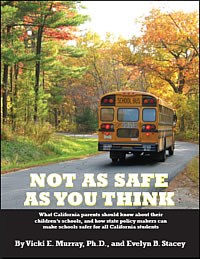The Pacific Research Institute (PRI), a free-market think tank based in California, found that ninety percent of California students currently attend schools with reported incidents of violence, physical injuries or weapons that resulted in disciplinary actions.
Not as Safe as You Think, by Vicki E. Murray, Ph.D., and Evelyn Stacey, analyzes current California safe schools policy. All students have the inalienable right to attend schools that are “safe, secure and peaceful” according to the California Constitution. Yet the definition of persistently dangerous schools devised by the state as required by of the federal No Child Left Behind Act is so narrow that not one of California’s more than 9,000 public schools has ever been deemed unsafe.
Under current state law, it takes a minimum of three years for any public school to be considered dangerous, and only if specified violations occur under certain conditions, and those violations result in a specified proportion of disciplinary actions. “California parents should not have to wait for years at a time before the state grants their children access to safe, secure, and peaceful schools,” said Dr. Murray. “Most important, students should not have to be victimized before their parents can take decisive action.”
Not as Safe as You Think finds that in spite of declining statewide enrollment, combined student suspensions and expulsions relating to school safety violations increased 7 percent, from 788,000 during the 2004-05 school to 845,000 during the 2007-08 school year. “Those figures actually understate the full prevalence of such incidents because only those resulting in student expulsions or suspensions are reported, not the number of actual incidents that occurred,” explained Evelyn Stacey.
It will take an act of Congress to repeal the requirement that states label schools “persistently dangerous,” an approach many federal officials and education experts agree is not achieving its intended goal of identifying unsafe schools. However, there are several improvements the state can make now that are recommended by leading state and federal agencies to enact common-sense safe schools policy:
- Report the number of actual school safety violations, not disciplinary actions.
- Base safety assessments on the most current year of data.
- Adopt a dangerous schools definition using objective criteria students and parents would use to determine the safety of a school.
- Guarantee parental notification by districts and schools.
- Guarantee students’ transfer options beyond their resident districts.
Not as Safe as You Think also includes extensive appendix tables detailing the 100 California schools with the most reported suspensions and expulsions in each safety category currently used under the state’s persistently dangerous schools definition. These categories include:
- Obscene/Disruptive/ Hostile/Intimidating Behavior;
- Violence/Physical Injury/Weapons;
- Drugs/Alcohol; and
- Vandalism/Stealing
“There is a growing consensus that the best judgment of parents trumps bureaucratic labels when it comes to assessing school safety. The proper role of the state should be to provide accurate information, then empower parents to act on it,” said Dr. Murray.

